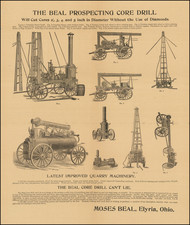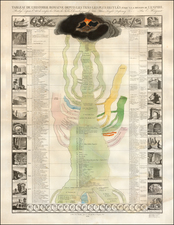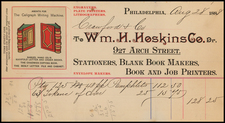Kermis Wind-Kraamer En Grossier is a Dutch satire published in Amsterdam in 1720, as part of Het Groote Tafereel der Dwaasheid (The Great Mirror of Folly). This satirical work emerged during the financial crisis of 1720 and offers a critical perspective on the events of that time.
The central image portrays a man with a windmill on top of his hat, seated in the air on clouds surrounding a sack of useless shares. Symbolizing the speculative bubble, he is distributing papers with his left hand. Behind him, two other men are depicted: one holds a candle that burns his fingers, representing the consequences of risky investments, while the other blows hot, cold, or lukewarm air with a bellows towards a cat attached to balloons. An ape sitting on a branch of a withered tree peers through a telescope at the cat, while a goose flies overhead.
In the right foreground, a duck carrying a barrel on its back approaches a chest filled with papers, symbolizing the burden it bears. Mice crawl over the papers, signifying the presence of deceit and fraud. Behind the chest, a toad approaches an ox, a reference to a fable where the toad wishes to enlarge itself to the same size as the ox, alluding to unrealistic ambitions.
The satirical elements of the engraving are complemented by engraved titles, inscriptions, and accompanying verses in both Dutch and French. These verses, authored by Q. Verwoude and S. Civilier respectively, provide further commentary on the financial folly and its consequences.
As a part of Het Groote Tafereel der Dwaasheid, the Kermis Wind-Kraamer En Grossier serves as a critical reflection of the financial crisis of 1720, offering a satirical portrayal of speculative activities, irrational exuberance, and the subsequent downfall. It provides a unique historical perspective on the events of the time and serves as a reminder of the risks and follies associated with financial speculation.









![(Temperance and Anti-Narcotics - Health and Social Reform) Pictorial Encyclopedia of Hygiene and Temperance [Anatomy, Physiology and Hygiene. Effects of Alcohol Upon the Human Stomach - Temperance Statistics; Effects of Narcotics and Stimulants; and three others]](https://storage.googleapis.com/raremaps/img/small/94877.jpg)
![(Mississippi Bubble) Kermis Wind-Kraamer En Grossier [Fair of the wholesale wind-pedlar.]](https://storage.googleapis.com/raremaps/img/small/95945.jpg)
![(Nuremberg Chronicle) [Geneology of the Tribes of Israel]](https://storage.googleapis.com/raremaps/img/small/98708.jpg)


